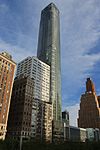New York Evening Post Building

The New York Evening Post Building, also known as the New York Post Building or the Post Towers, is a historic commercial building located in Lower Manhattan, New York City, New York. The building was designed by architect Horace Trumbauer and built in 1926. The Post Building is a 17-story, Art Deco style steel frame and masonry building with abundant terra cotta and Guastavino tile embellishments. The building has setbacks beginning at the seventh floor and a "U" shaped light well. The New York Evening Post previously occupied the Old New York Evening Post Building from 1906 to 1926. It occupied this building, which is now an apartment building, until 1970.: 3, 5, 8 The building was added to the National Register of Historic Places on September 22, 2000.
Excerpt from the Wikipedia article New York Evening Post Building (License: CC BY-SA 3.0, Authors, Images).New York Evening Post Building
West Street, New York Manhattan
Geographical coordinates (GPS) Address Nearby Places Show on map
Geographical coordinates (GPS)
| Latitude | Longitude |
|---|---|
| N 40.708888888889 ° | E -74.015 ° |
Address
West Street (West Side Highway)
West Street
10280 New York, Manhattan
New York, United States
Open on Google Maps








